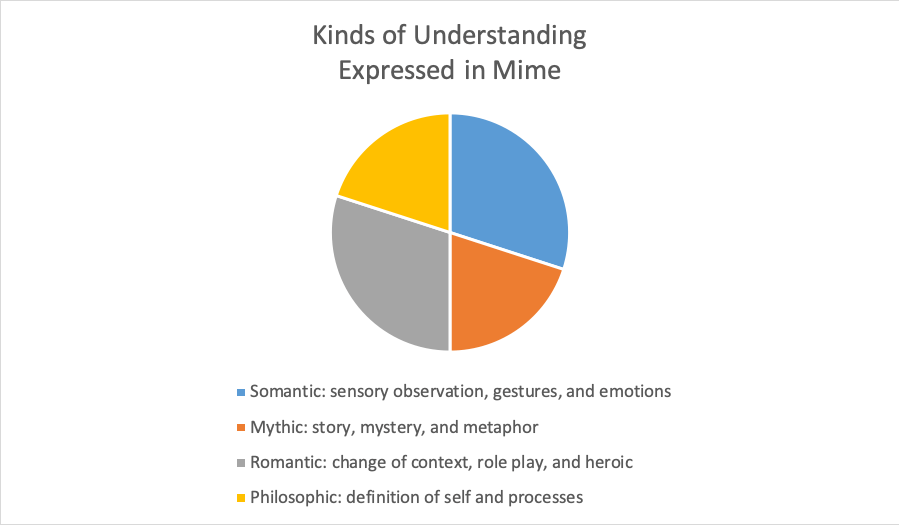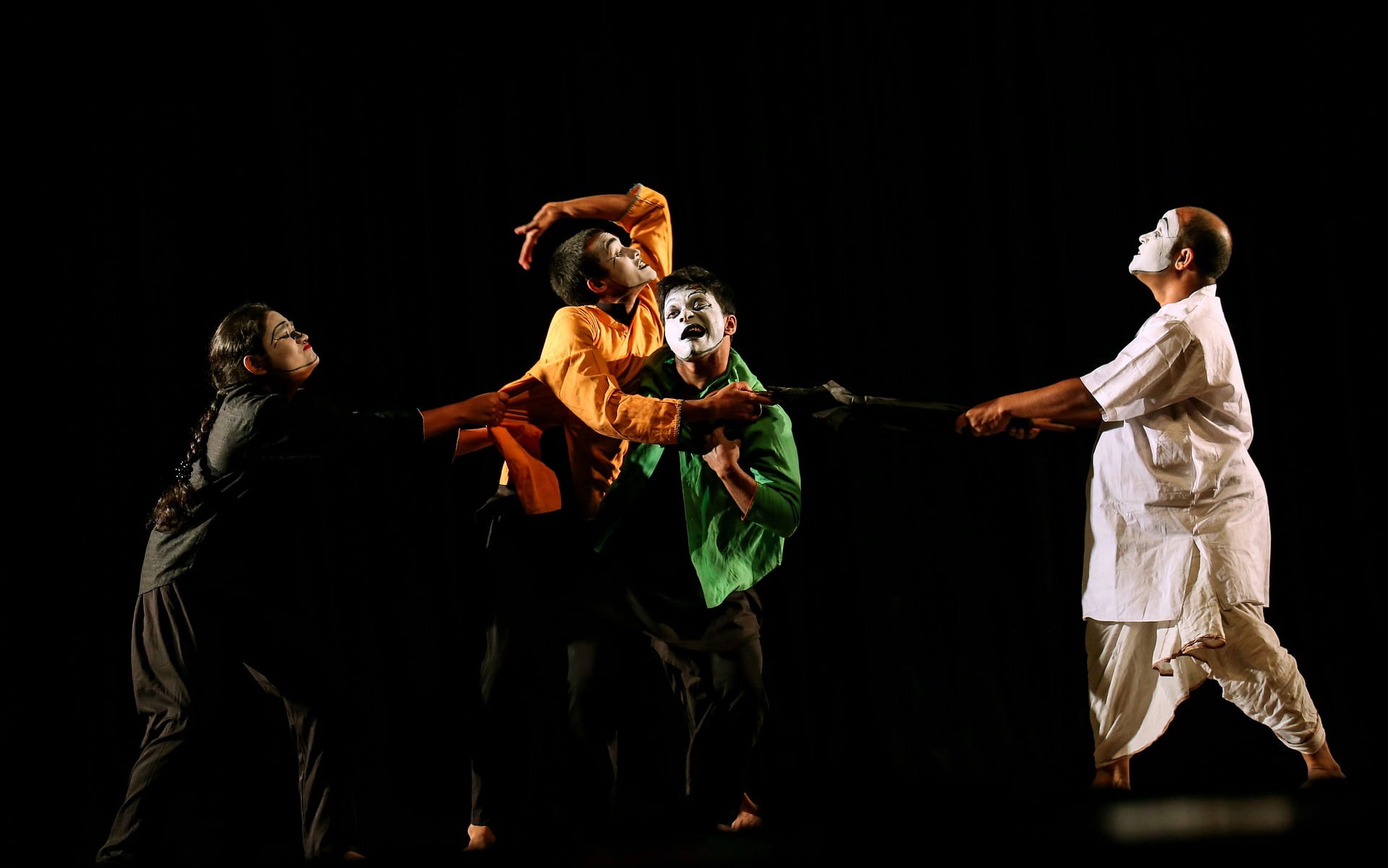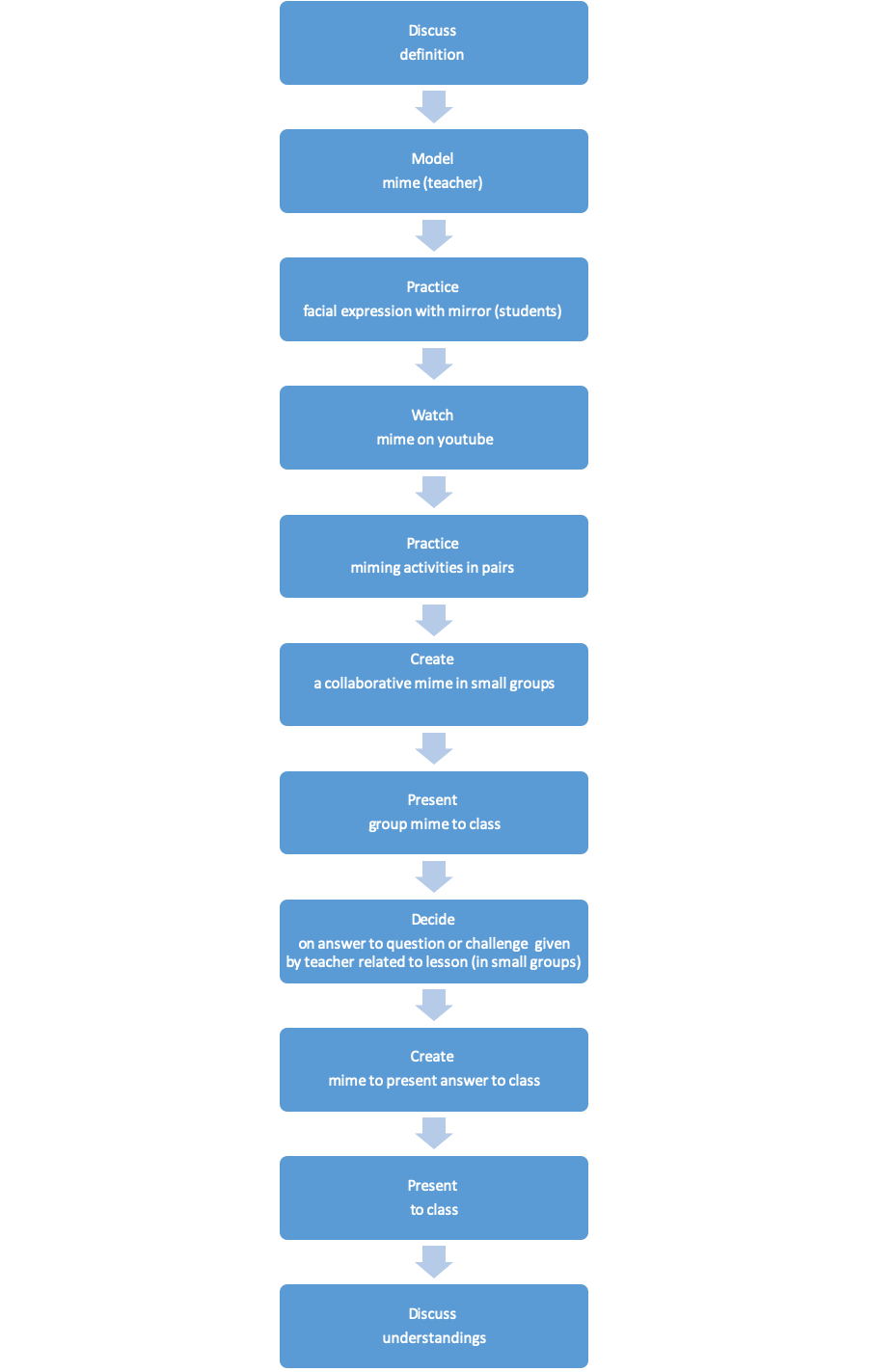 By Karen M Effa (Educator, MEd in IE; IE mentor)
By Karen M Effa (Educator, MEd in IE; IE mentor)
Stoked about the Somatic? This entry is a sequel to Karen’s first “Spotlight on the Somatic” post which you can read here.
“Mime creates space by making visible the invisible” (Shope, 1989, p. 15).
Looking for a simple, yet significant, way to engage students and personalize their learning? A key challenge, for most teachers, is engaging students’ interest, keeping their attention, and then discerning whether or not they have attained a deeper understanding of the material. With activities of the mind closeted in the skull, teachers are left looking for external clues to internal growth. Today I would like to share a tool that could provide teachers with a solution: Mime.
The beauty and power of mime is that it not only provides an impetus for the student to explore new material, but it also showcases what is understood. With a little thought and preparation, mime can become a formidable ally in facilitating learning in our classrooms.
Steeped in which kinds of understanding?
As an Imaginative Educator, I seek to discern what Kinds of Understanding my students are primarily functioning in, so that I can zero in on the most effective cognitive tools. I continue to be particularly intrigued by the cognitive tools in the Somatic Kind of Understanding, as I believe that their power to promote cognitive growth at any age is underestimated. The creator of Imaginative Education, Kieran Egan, explains in his book, The Educated Mind, that “Somatic exploration sets the foundational development of understanding, particularly by building the framework of space, time, causality, effort and response” (1997, p. 242). Why do so many of us view the first set of cognitive tools as becoming less potent with each successive school year? Cant, the author of Unswaddling Pedagogy, shares research which reveals a link “between embodied cognition and three qualities of creative thought: creative generation, cognitive flexibility, and remote association” (p. 199). Dr. Gregory Lendvay, in his blog post “Movements to Engage the Body,” emphasizes that “any concept can be embodied in action and movement.” Somatic cognitive tools can connect the student with content in a powerful and personal way.
Although mime is grounded in the Somatic, cognitive tools from most of the other Understandings are part of this experience. The pie chart below summarizes the tools which mime incorporates. Mime is both broad and deep in Kinds of Understanding and cognitive tools.
Magnetic and Marvelous Mime
Why do most students find mime intriguing? Shope explains that “the physical and emotional activity of the mime motivates children to want to participate on all levels of intelligent activity” (p. 2). The removal of language, when expressing understanding, requires deeper thinking on the actual subject matter. A topic must be pulled apart thoroughly in order to represent it through mime. Mime is magnetic, because it is physically active and challenges the student to take ownership of their learning. It is also accessible and inclusive. Mime is marvelous for the teacher, because it does not require special resources, is extremely flexible as to subject matter, and makes visible student learning.
Mime in the Classroom
My first experience with the power of mime was while volunteering in a grade one classroom. Faced with students who were tired and antsy, just wanting to get to lunch break, the seasoned teacher suddenly stopped using words to direct the class and switched to gestures. With a few hand movements, she communicated eyes on me, no talking, find this resource in your desk, open to this page, so-and-so collect that and bring it to me etc. After a minute of confusion, a magical transformation came over these restless students. It became a mystery, then a game, then a challenge.
Can I figure out what the teacher wants? Will I be the first one to get it right?
The attention and enthusiasm was stunning. The rest of the class went smoothly and in an organized fashion. Not until they filed out for lunch break were they allowed to speak and we heard laughter through the open door. Whether it was the relief of novelty or the relief of respite from following auditory instructions, it was effective and an experience I’ll never forget.
I used mime in my grade five/six class, in a Career Education unit focussing on the social skills and personal awareness required to express inclusivity and respect. After some preparatory lessons, I divided the class into small groups, giving each one a scenario dealing with our topic. They were free to decide on how to communicate their solution to their peers. My class loved it. They were engaged, enthusiastic, and creative.
Although mime seems to be such an easy activity, it requires students to break something down into its separate parts, both physically and emotionally. To successfully present their anecdote, they needed to gain a change of perspective, step into someone else’s shoes, and feel the emotions of the situation. By moving their body through the narrative, they gained a heightened awareness of the communicative and emotional power of body language. They were not only sharing their solution with their peers but also experiencing it through their bodies.
Impact on the observing students was also profound. The physicality of the emotion expressed in the scenarios deepened student understanding, as they connected the topic to their own experiences. The absence of sound created space for a laser focus, receptivity, and personal application of the message.
Scope and Sequence
Mime requires a physical self-awareness and emotional connectedness that can’t be taken for granted. If your students are unfamiliar with mime, I would recommend several introductory lessons before asking them to use this cognitive tool to explore topics in the curriculum. The following scope and sequence will build the required skills. As your students become more familiar with mime, you will have different starting places.
I am so looking forward to getting back into the classroom to continue experimenting with the use of cognitive tools, especially those found in the Somatic Kind of Understanding. And for me, mime is at the top of the list to explore. I vote we officially add it to our list of cognitive tools.
“The bodily-kinesthetic energy within each student may prove to be one of the vast untapped resources available to educators everywhere” (Shope, p. 22).
References
Cant, A. (2017). Unswaddling pedagogy. (Dissertation paper)
Egan, K. (1997). The educated mind: How cognitive tools shape our understanding. Chicago, IL: The University of Chicago Press.
Lendvay, G. (December 2016). Participatory story-telling: An example for social studies. ImaginEd, blog post. Retrieved from
http://www.educationthatinspires.ca/2016/12/06/participatory-story-telling-an-example-for-social-studies/
Shope, R. (1989). Mime as a mode of intelligence. Non-journal, 1-23. Retrieved from
https://files.eric.ed.gov/fulltext/ED311501.pdf
Resources To Kick-Start Miming in the Classroom:
Drama Lesson Activities, Grades 4-6: Exploring Mime
Tips for Teachers: Working with Gestures and Mime—5 Classroom Activities
From Expert Village:
How to Mime Leaning
How to Mime Opening Doors
How to Mime Lifting
How to Use Objects in Mime
Example of Mime Stories (model and motivate)
ET the Mime – The Car
ET the Mime – The Date




